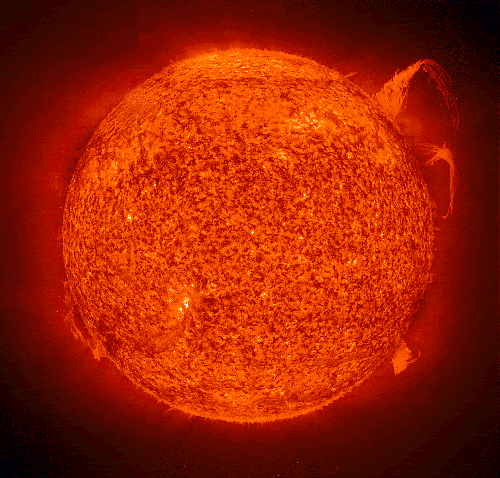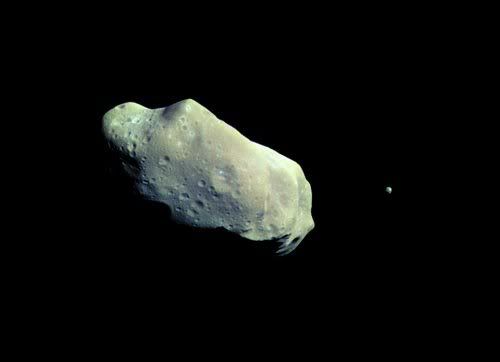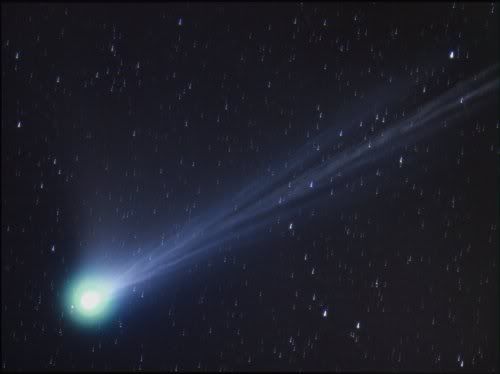|
The Solar
System
The Solar System consists of the Sun and those
celestial objects bound to it by gravity: the eight planets and five dwarf
planets, their 173 known moons, and billions of small bodies. The small bodies
include asteroids, icy Kuiper belt objects, comets, meteoroids, and
interplanetary dust.
The charted regions of the Solar System comprise the
Sun, four terrestrial inner planets, the asteroid belt, four gas giant outer
planets, and finally the Kuiper belt and the scattered disc. The hypothetical
Oort cloud may also exist at a distance roughly a thousand times beyond these
regions.
The solar wind, a flow of plasma from the Sun,
permeates the Solar System, creating a bubble in the interstellar medium known
as the heliosphere, which extends out to the middle of the scattered disc.
In order of their distances from the Sun, the eight
planets are:
- Mercury (57,900,000 km)
- Venus (108,000,000 km)
- Earth (150,000,000 km)
- Mars (228,000,000 km)
- Jupiter (779,000,000 km)
- Saturn (1,430,000,000 km)
- Uranus (2,880,000,000 km)
- Neptune (4,500,000,000 km)
As of mid-2008, five smaller objects are classified as
dwarf planets, all but the first of which orbit beyond Neptune. These are:
- Ceres (415,000,000 km, in the asteroid belt;
formerly classed as the fifth planet)
- Pluto (5,906,000,000 km, formerly classified as
the ninth planet)
- Haumea (6,450,000,000 km)
- Makemake (6,850,000,000 km)
- Eris (10,100,000,000 km)
Six of the planets and three of the dwarf planets are
orbited by natural satellites, usually termed "moons" after Earth's Moon. Each
of the outer planets is encircled by planetary rings of dust and other
particles.

The Sun
The Sun, an average-sized, middle-aged star, formed almost 5 billion years ago
from a cloud of gas and dust.

Mercury
Mercury, the closest planet to the Sun, takes only 88 days to orbit the Sun.

Venus
The surface of Venus, the brightest object in the sky after the Sun and Moon, is
covered with craters, mountains, volcanoes, and lava plains.

Earth
Earth is the third planet from the Sun and takes 23 hours, 56 minutes to spin on
its axis one time.

The Moon
The Moon, located 238,000 miles from Earth, has a temperature of 225° F during
the day and drops down to –243° at night.

Mars
Rust in the soil creates the Red Planet's signature color.

Jupiter
Jupiter is the largest planet in our solar system,
with a diameter of 89,000 miles.

Saturn
Saturn, the sixth planet from the Sun, has a ring system made up of ice and rock
particles, some as big as a minivan.

Uranus
Uranus, the third-largest planet in the solar system, has an
average temperature of –350° F and does not have a solid surface.

Neptune
Neptune has 13 moons, the two largest are Triton and Nereid.

Pluto
Pluto, reclassified as a dwarf planet in 2006, is located nearly 40 times as far
from the Sun as Earth.

Asteroids
Asteroids, chunks of rock and metal that orbit the Sun, sometimes collide with
the Earth. This is one possible explanation for the extinction of dinosaurs.

Comets
Comets, thought to be leftovers of the early solar system, are made of dust,
rocks, organic.
|
 visitor
visitor














No comments:
Post a Comment